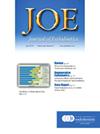Development of a Core Outcome Set in Endodontics (COS-ENDO): Part 2 – COS-ENDO for Studies of Nonsurgical Root Canal Treatment and Retreatment in Permanent Teeth
IF 3.5
2区 医学
Q1 DENTISTRY, ORAL SURGERY & MEDICINE
引用次数: 0
Abstract
Introduction
Methodological heterogeneity and reporting bias complicate interpreting endodontic outcomes. Supported by the American Association of Endodontists and its Foundation, this study developed the Core Outcome Set in Endodontics (COS-ENDO) to standardize reporting for studies of Nonsurgical Root Canal Treatment/Retreatment, Surgical Endodontics, Vital Pulp Therapy, Apexification, and Regenerative Endodontics. This article, Part 2 of a 5-part series, focuses on COS-ENDO for Nonsurgical Root Canal Treatment/Retreatment, while other parts address the remaining treatments.
Methods
Outcomes were identified through scoping reviews, a qualitative study with patients, and a web-based survey of American Association of Endodontists practicing members. In a 2-round Delphi survey, clinicians, patients, and researchers rated outcomes on a 9-point scale. Ratings were assessed against consensus criteria, and a virtual meeting finalized COS-ENDO.
Results
Of the 97 invited participants to Round 1, 77 registered, and 73 (24 Academicians/Researchers, 26 Clinicians, and 23 Patients (or their parents/caregivers)) assessed 39 outcomes, with 18 excluded. The remaining outcomes—7 achieving consensus for inclusion and 14 lacking consensus—advanced to Round 2 for re-rating by 70 participants. This resulted in 9 outcomes achieving consensus for inclusion, and 12 lacking consensus. In the final meeting, 16 participants finalized the COS-ENDO for Nonsurgical Root Canal Treatment/Retreatment, including Tooth survival, Pain, Signs of infection, Radiographic evidence of periradicular healing, Success, Functional tooth, Need for further intervention, and Adverse events/Complications.
Conclusions
COS-ENDO is an important step in standardizing outcome reporting in endodontics, ensuring consistent reporting and enhancing research utility. Further efforts are needed to establish optimal measurement methods.
牙髓学核心结果集(COS-ENDO)的发展。第二部分:恒牙非手术根管治疗和再治疗的COS-ENDO研究。
方法异质性和报告偏倚使根管治疗结果的解释复杂化。在美国牙髓医师协会(AAE)及其基金会的支持下,本研究制定了牙髓学核心结果集(os - endo),以规范非手术根管治疗/再治疗、手术牙髓学、重要牙髓治疗、根尖化和再生牙髓学的研究报告。本文是5部分系列的第2部分,重点介绍了COS-ENDO在非手术根管治疗/再治疗中的应用,而其他部分则讨论了其余的治疗方法。方法:通过范围评估、对患者的定性研究和对AAE执业成员的网络调查来确定结果。在两轮德尔菲调查中,临床医生、患者和研究人员以9分制对结果进行评分。根据协商一致的标准评估了评级,虚拟会议最终确定了COS-ENDO。结果:在受邀参加第1轮的97名参与者中,77人注册,73人(24名院士/研究人员,26名临床医生和23名患者(或其父母/照顾者)评估了39项结果,其中18项被排除。剩下的结果——7个达成共识,14个缺乏共识——进入第二轮,由70个参与者重新评级。这导致9个结果对纳入达成共识,12个结果缺乏共识。在最后的会议上,16名参与者最终确定了非手术根管治疗/再治疗的COS-ENDO,包括牙齿存活、疼痛、感染迹象、根周愈合的影像学证据、成功、牙齿功能、进一步干预的需要以及不良事件/并发症。结论:COS-ENDO是规范牙髓学结果报告、保证报告一致性、提高研究实用性的重要一步。需要进一步努力建立最佳的测量方法。
本文章由计算机程序翻译,如有差异,请以英文原文为准。
求助全文
约1分钟内获得全文
求助全文
来源期刊

Journal of endodontics
医学-牙科与口腔外科
CiteScore
8.80
自引率
9.50%
发文量
224
审稿时长
42 days
期刊介绍:
The Journal of Endodontics, the official journal of the American Association of Endodontists, publishes scientific articles, case reports and comparison studies evaluating materials and methods of pulp conservation and endodontic treatment. Endodontists and general dentists can learn about new concepts in root canal treatment and the latest advances in techniques and instrumentation in the one journal that helps them keep pace with rapid changes in this field.
 求助内容:
求助内容: 应助结果提醒方式:
应助结果提醒方式:


